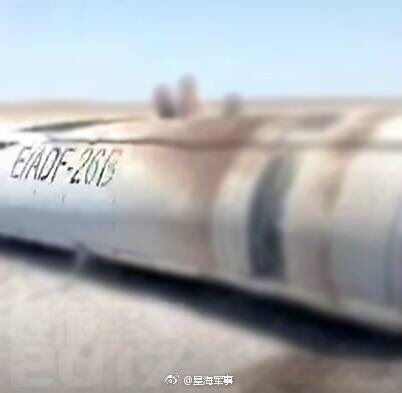I would bet real money that China plans to build a third array that covers the entire SCS and Malacca Strait and also overlaps the second array. A fourth array covering Bay of Bengal and Andaman Sea is also highly likely (eventually) IMO.Thanks for the write-ups about China's OTH-B radars. One question: it is acknowledged that China will likely seek to build several more radars to cover all points of the compass, including overlap. At the same time, the existence of a second OTH-B array has only been determined because one of the receive stations was identified by satellite imagery. Does this not therefore suggest that China could already have, or already be working on, several more radars that foreseen for the future, and that these have simply not been identified?
TL;DR: How sure are we that this is in fact China's second OTH-B array, rather than e.g. its fourth?
You are using an out of date browser. It may not display this or other websites correctly.
You should upgrade or use an alternative browser.
You should upgrade or use an alternative browser.
China's Anti-Access ASBM Strategy [Defense News]
- Thread starter mxiong
- Start date
Hendrik_2000
Lieutenant General
Arthur Ericson testimony in front of congress Basically he updated his numerous paper on the subject. He now says the missile work and China has in place reconnaissance and tracking system but he now said it could be expensive and could be exploited. I'm not sure that would be the case in the future as China is now researching quantum satellite communication. It is a long article Here is the link
Here is the complete videohttps://
By offering reliable location signals, PNT satellites in China’s growing Beidou/Compass constellation help implement targeting by helping to ensure that a missile reaches a desired location. If the intended latitude-longitude location is correct in practice, then the missile should see the target and strike it. Such satellite navigation offers a linchpin that the USSR could never achieve through its more limited focus on inertial navigation. Additionally, the constellation’s text message communications function supports reconnaissance and reporting. China has launched nearly thirty Beidou/Compass PNT satellites (the latest on 12 June 2016). Twenty are currently functional in orbit. First operational as Beidou I in 2000, the system went operational with 10 satellites as Beidou II in 2011, and achieved regional coverage in 2012. China appears on track to achieve its goal of a 35-satellite constellation with global coverage by 2020.[28]
Imaging satellites, based of necessity in low-earth orbit, take snapshots of pre-designated areas at periodic and predictable times. Examining satellites’ numbers, orbits, inclinations, and periods therefore offers a general sense of coverage. China’s reconnaissance-capable satellites include electro-optical (EO), multi- and hyperspectral; as well as radar satellites, especially synthetic aperture radar (SAR) variants. SAR satellites can provide targeting information, while other satellites can facilitate target identification. Maritime-relevant variants include the Fengyun, China-Brazil Earth Resources (CBERS), Ziyuan, Haiyang, Huanjing, Yaogan, Gaofen, and Jilin satellites.
Here is the summary
US Concern Mounts About Chinese Military Modernization, Navy Size, Hypersonic Weapons
Navy
Monday at 6:03 PM
China experts told Congress about growing concerns regarding Chinese military modernization such as nuclear weapons, Navy fleet growth, hypersonic weapons and submarines.
By Daniel L. Kuester, U.S. Naval War College Public Affairs
Feb. 27, 2017
NEWPORT, R.I. – An expert on the faculty of U.S. Naval War College (NWC) in Newport, Rhode Island updated Congress on China’s current military capabilities, possible intentions, and what he sees as the future options in the region at a governmental committee meeting.
Andrew S. Erickson, professor of strategy at NWC in the China Maritime Studies Institute testified before the U.S.-China Economic and Security Review Commission (USCC) in the Dirksen Senate Office Building in Washington.
“My key points are, with its ambitious ASBM (anti-ship ballistic missile) development, China is challenging U.S. Asia-Pacific interests and military influence in new ways,” said Erickson. “This is part of a much larger Chinese counter-intervention effort that is advancing significantly regardless of precise ASBM capabilities or limitations. While China’s missiles pose potential challenges to U.S. forces, ensuring that they can be targeted effectively is expensive and creates growing space-based electromagnetic spectrum vulnerabilities that can be exploited.”
The hearing was co-chaired by Carolyn Bartholomew and Sen. James Talent of Missouri.
Erickson went on to say that select regions are particularly active for the Chinese military right now.
“In what it (China) considers the near seas (the Yellow Sea, East China Sea, and the South China Sea), Beijing enjoys powerful synergies and advantages vis-à-vis the disputed sovereignty claims it pursues there,” Erickson testified, “increasingly in defiance of regional stability and international laws and norms, and supported by precision-targeted systems designed to challenge American sea control and make American intervention risky.”
The panel was titled “China’s Hypersonic and Maneuverable Re-Entry Vehicle Programs” and also included James Acton, co-director of Nuclear Policy Program and senior fellow, Carnegie Endowment for International Peace; and Mark Stokes, executive director, Project 2049 Institute.
In closing, Erickson gave USCC some direction on where U.S. policy might go next.
“U.S. policymakers should enhance efforts at developing tailored countermeasures, particularly concerning electronic warfare,” Erickson said. “(U.S. should also) attempt to ensure that China doesn’t develop Scarborough Shoal into a key targeting node in the South China Sea, and increase U.S. Navy ship numbers to avoid presenting China with an over-concentrated target set.”
The USCC was created by the United States Congress in October 2000 with the legislative mandate to monitor, investigate, and submit to Congress an annual report on the national security implications of the bilateral trade and economic relationship between the United States and the People’s Republic of China, and to provide recommendations, where appropriate, to Congress for legislative and administrative action.
Here is the complete videohttps://
By offering reliable location signals, PNT satellites in China’s growing Beidou/Compass constellation help implement targeting by helping to ensure that a missile reaches a desired location. If the intended latitude-longitude location is correct in practice, then the missile should see the target and strike it. Such satellite navigation offers a linchpin that the USSR could never achieve through its more limited focus on inertial navigation. Additionally, the constellation’s text message communications function supports reconnaissance and reporting. China has launched nearly thirty Beidou/Compass PNT satellites (the latest on 12 June 2016). Twenty are currently functional in orbit. First operational as Beidou I in 2000, the system went operational with 10 satellites as Beidou II in 2011, and achieved regional coverage in 2012. China appears on track to achieve its goal of a 35-satellite constellation with global coverage by 2020.[28]
Imaging satellites, based of necessity in low-earth orbit, take snapshots of pre-designated areas at periodic and predictable times. Examining satellites’ numbers, orbits, inclinations, and periods therefore offers a general sense of coverage. China’s reconnaissance-capable satellites include electro-optical (EO), multi- and hyperspectral; as well as radar satellites, especially synthetic aperture radar (SAR) variants. SAR satellites can provide targeting information, while other satellites can facilitate target identification. Maritime-relevant variants include the Fengyun, China-Brazil Earth Resources (CBERS), Ziyuan, Haiyang, Huanjing, Yaogan, Gaofen, and Jilin satellites.
Here is the summary
US Concern Mounts About Chinese Military Modernization, Navy Size, Hypersonic Weapons
Navy
Monday at 6:03 PM
China experts told Congress about growing concerns regarding Chinese military modernization such as nuclear weapons, Navy fleet growth, hypersonic weapons and submarines.
By Daniel L. Kuester, U.S. Naval War College Public Affairs
Feb. 27, 2017
NEWPORT, R.I. – An expert on the faculty of U.S. Naval War College (NWC) in Newport, Rhode Island updated Congress on China’s current military capabilities, possible intentions, and what he sees as the future options in the region at a governmental committee meeting.
Andrew S. Erickson, professor of strategy at NWC in the China Maritime Studies Institute testified before the U.S.-China Economic and Security Review Commission (USCC) in the Dirksen Senate Office Building in Washington.
“My key points are, with its ambitious ASBM (anti-ship ballistic missile) development, China is challenging U.S. Asia-Pacific interests and military influence in new ways,” said Erickson. “This is part of a much larger Chinese counter-intervention effort that is advancing significantly regardless of precise ASBM capabilities or limitations. While China’s missiles pose potential challenges to U.S. forces, ensuring that they can be targeted effectively is expensive and creates growing space-based electromagnetic spectrum vulnerabilities that can be exploited.”
The hearing was co-chaired by Carolyn Bartholomew and Sen. James Talent of Missouri.
Erickson went on to say that select regions are particularly active for the Chinese military right now.
“In what it (China) considers the near seas (the Yellow Sea, East China Sea, and the South China Sea), Beijing enjoys powerful synergies and advantages vis-à-vis the disputed sovereignty claims it pursues there,” Erickson testified, “increasingly in defiance of regional stability and international laws and norms, and supported by precision-targeted systems designed to challenge American sea control and make American intervention risky.”
The panel was titled “China’s Hypersonic and Maneuverable Re-Entry Vehicle Programs” and also included James Acton, co-director of Nuclear Policy Program and senior fellow, Carnegie Endowment for International Peace; and Mark Stokes, executive director, Project 2049 Institute.
In closing, Erickson gave USCC some direction on where U.S. policy might go next.
“U.S. policymakers should enhance efforts at developing tailored countermeasures, particularly concerning electronic warfare,” Erickson said. “(U.S. should also) attempt to ensure that China doesn’t develop Scarborough Shoal into a key targeting node in the South China Sea, and increase U.S. Navy ship numbers to avoid presenting China with an over-concentrated target set.”
The USCC was created by the United States Congress in October 2000 with the legislative mandate to monitor, investigate, and submit to Congress an annual report on the national security implications of the bilateral trade and economic relationship between the United States and the People’s Republic of China, and to provide recommendations, where appropriate, to Congress for legislative and administrative action.
Last edited:
Equation
Lieutenant General
Arthur Ericson testimony in front of congress Basically he updated his numerous paper on the subject. He now says the missile work and China has in place reconnaissance and tracking system but he now said it could be expensive and could be exploited. I'm not sure that would be the case in the future as China is now researching quantum satellite communication. It is a long article Here is the link
Here is the complete videohttps://
By offering reliable location signals, PNT satellites in China’s growing Beidou/Compass constellation help implement targeting by helping to ensure that a missile reaches a desired location. If the intended latitude-longitude location is correct in practice, then the missile should see the target and strike it. Such satellite navigation offers a linchpin that the USSR could never achieve through its more limited focus on inertial navigation. Additionally, the constellation’s text message communications function supports reconnaissance and reporting. China has launched nearly thirty Beidou/Compass PNT satellites (the latest on 12 June 2016). Twenty are currently functional in orbit. First operational as Beidou I in 2000, the system went operational with 10 satellites as Beidou II in 2011, and achieved regional coverage in 2012. China appears on track to achieve its goal of a 35-satellite constellation with global coverage by 2020.[28]
Imaging satellites, based of necessity in low-earth orbit, take snapshots of pre-designated areas at periodic and predictable times. Examining satellites’ numbers, orbits, inclinations, and periods therefore offers a general sense of coverage. China’s reconnaissance-capable satellites include electro-optical (EO), multi- and hyperspectral; as well as radar satellites, especially synthetic aperture radar (SAR) variants. SAR satellites can provide targeting information, while other satellites can facilitate target identification. Maritime-relevant variants include the Fengyun, China-Brazil Earth Resources (CBERS), Ziyuan, Haiyang, Huanjing, Yaogan, Gaofen, and Jilin satellites.
Here is the summary
US Concern Mounts About Chinese Military Modernization, Navy Size, Hypersonic Weapons
Navy
Monday at 6:03 PM
China experts told Congress about growing concerns regarding Chinese military modernization such as nuclear weapons, Navy fleet growth, hypersonic weapons and submarines.
By Daniel L. Kuester, U.S. Naval War College Public Affairs
Feb. 27, 2017
NEWPORT, R.I. – An expert on the faculty of U.S. Naval War College (NWC) in Newport, Rhode Island updated Congress on China’s current military capabilities, possible intentions, and what he sees as the future options in the region at a governmental committee meeting.
Andrew S. Erickson, professor of strategy at NWC in the China Maritime Studies Institute testified before the U.S.-China Economic and Security Review Commission (USCC) in the Dirksen Senate Office Building in Washington.
“My key points are, with its ambitious ASBM (anti-ship ballistic missile) development, China is challenging U.S. Asia-Pacific interests and military influence in new ways,” said Erickson. “This is part of a much larger Chinese counter-intervention effort that is advancing significantly regardless of precise ASBM capabilities or limitations. While China’s missiles pose potential challenges to U.S. forces, ensuring that they can be targeted effectively is expensive and creates growing space-based electromagnetic spectrum vulnerabilities that can be exploited.”
The hearing was co-chaired by Carolyn Bartholomew and Sen. James Talent of Missouri.
Erickson went on to say that select regions are particularly active for the Chinese military right now.
“In what it (China) considers the near seas (the Yellow Sea, East China Sea, and the South China Sea), Beijing enjoys powerful synergies and advantages vis-à-vis the disputed sovereignty claims it pursues there,” Erickson testified, “increasingly in defiance of regional stability and international laws and norms, and supported by precision-targeted systems designed to challenge American sea control and make American intervention risky.”
The panel was titled “China’s Hypersonic and Maneuverable Re-Entry Vehicle Programs” and also included James Acton, co-director of Nuclear Policy Program and senior fellow, Carnegie Endowment for International Peace; and Mark Stokes, executive director, Project 2049 Institute.
In closing, Erickson gave USCC some direction on where U.S. policy might go next.
“U.S. policymakers should enhance efforts at developing tailored countermeasures, particularly concerning electronic warfare,” Erickson said. “(U.S. should also) attempt to ensure that China doesn’t develop Scarborough Shoal into a key targeting node in the South China Sea, and increase U.S. Navy ship numbers to avoid presenting China with an over-concentrated target set.”
The USCC was created by the United States Congress in October 2000 with the legislative mandate to monitor, investigate, and submit to Congress an annual report on the national security implications of the bilateral trade and economic relationship between the United States and the People’s Republic of China, and to provide recommendations, where appropriate, to Congress for legislative and administrative action.
So much for those China ASBM "needs to be proven at hitting a moving target at sea in order to be legit" naysayers.
Hendrik_2000
Lieutenant General
Interesting observation from Henri K He said DF 26 doesn't need prepared site or fix coordinate and can be fired from anywhere accessible by TEL. He speculate a new brigade is forming in Yunnan We know there are already 2 brigades with possible 1 forming. Any foe need to run the gauntlet of DF 26
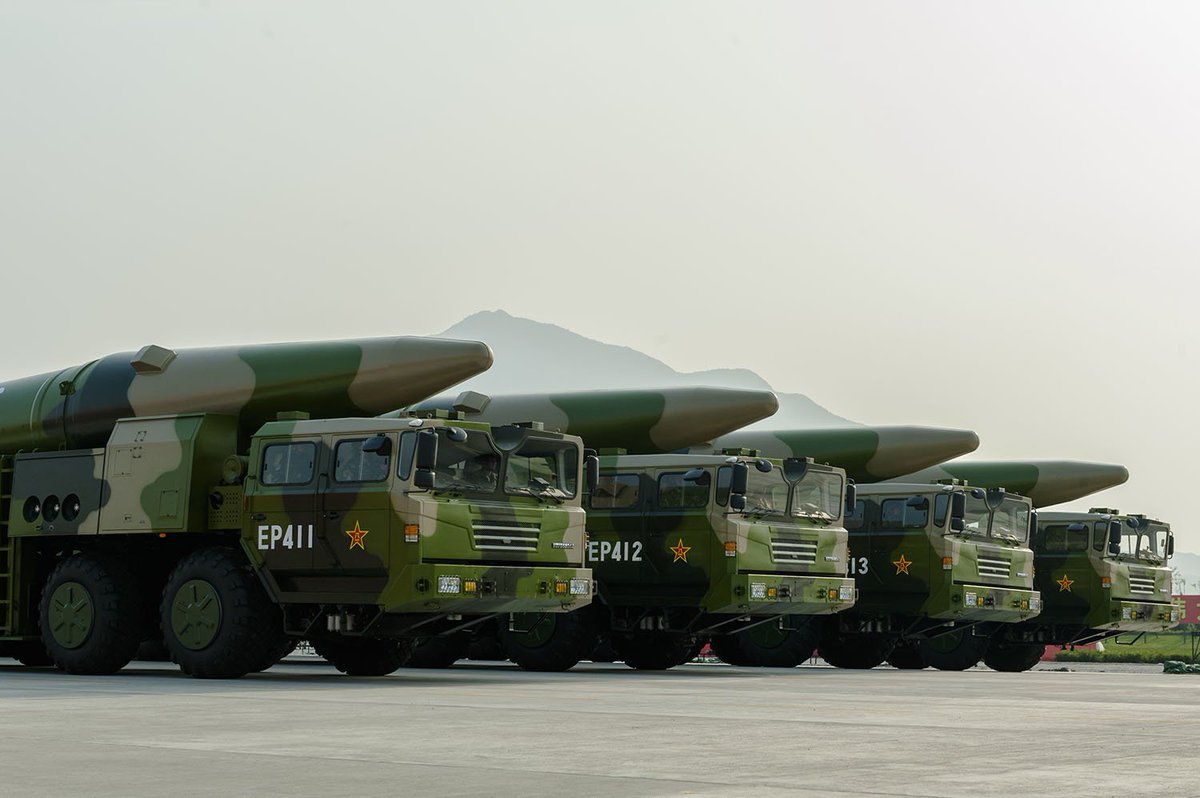
A brigade of Chinese rocket forces recently conducted a nocturnal exercise during whichDF-26 long range ballistic missile simulations were conducted, based on a new TV report from the national channel CCTV-7.
Although the military journalists of the Chinese army did not reveal any information about the missile unit, location or even the missile model, it was still possible to identify the missile with a few images identified in the video .
Indeed, the TELs (Tractor-Erector-Launcher) vehicles that can be seen at the beginning of the report have six axles, two in the front and four in the rear. This configuration is typical of the TEL 12 × 12 of DF-26, model HTF-5680 designed by the Taian subsidiary of the Chinese group CASC.
One can also notice the conical "hollow", of particular shape which distinguishes it from that of the TELs of DF-21C and DF-21D, which can be seen in the middle of the driver's cabin in a passage of the video.
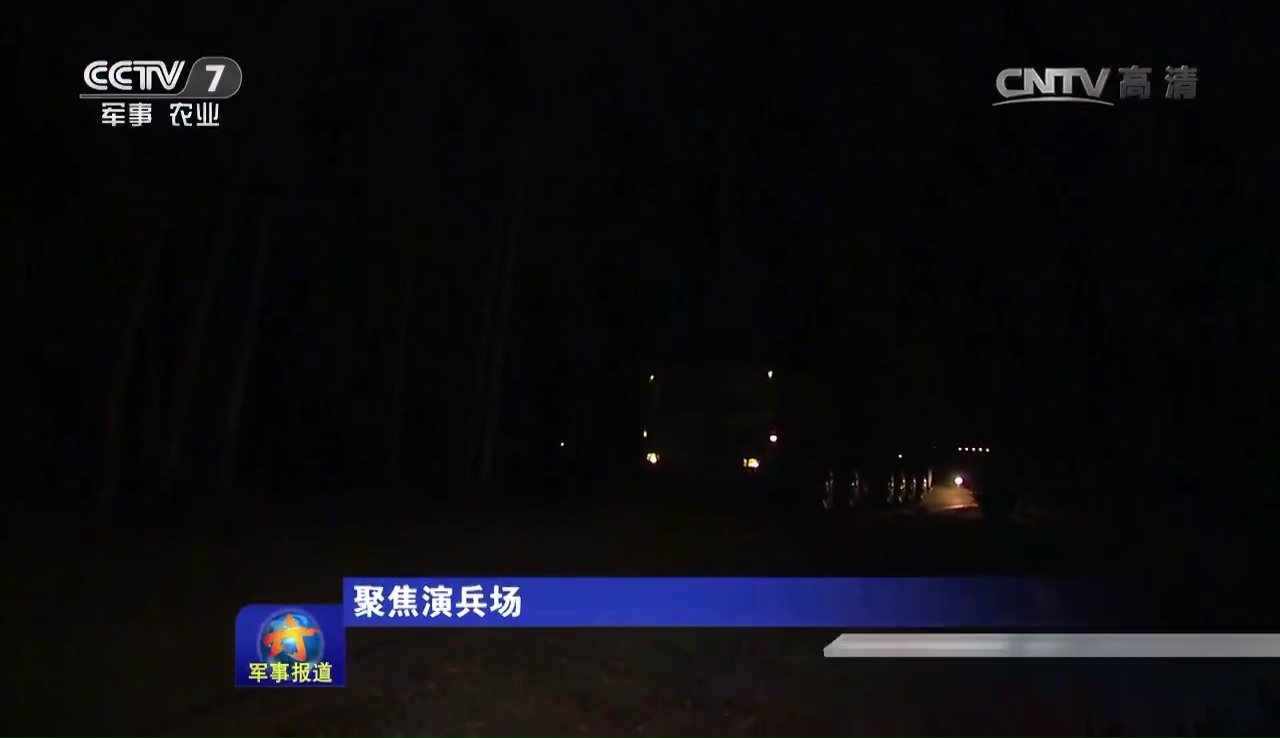
The TEL 12 × 12 of the DF-26
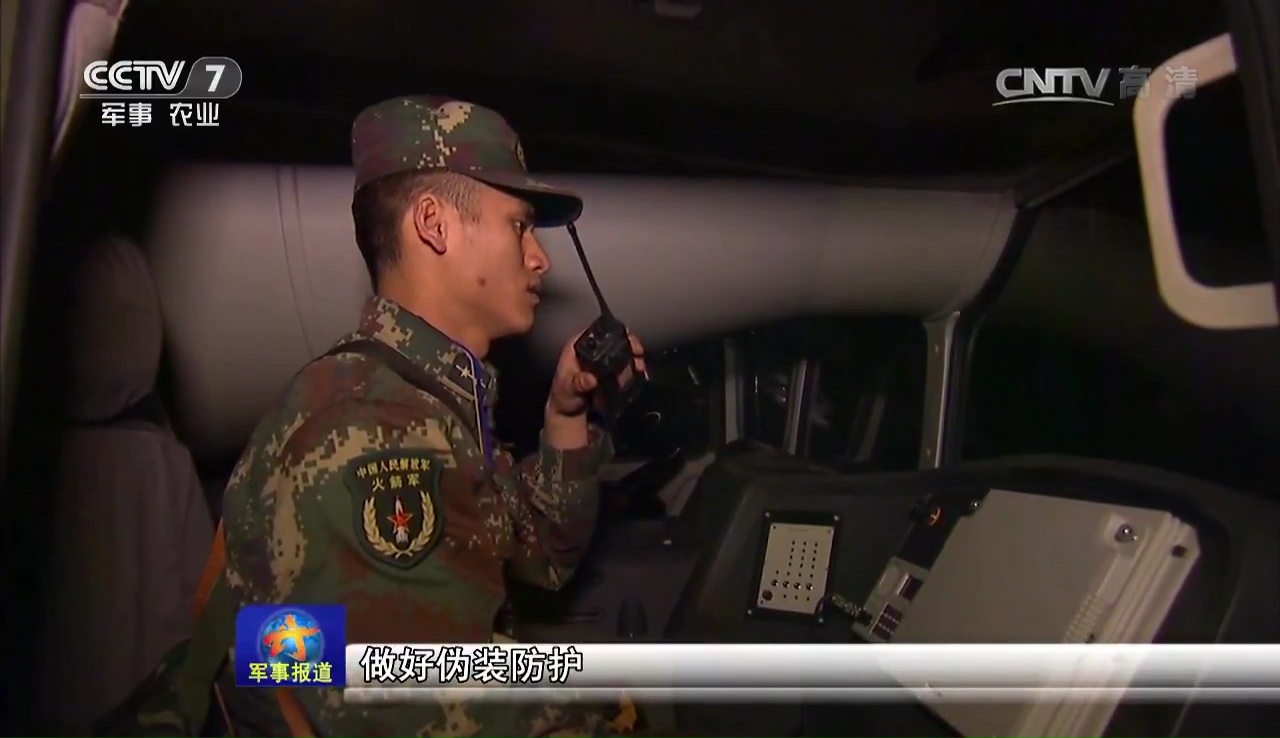
DF-26 TEL cab, noticing conical shape in the middle.
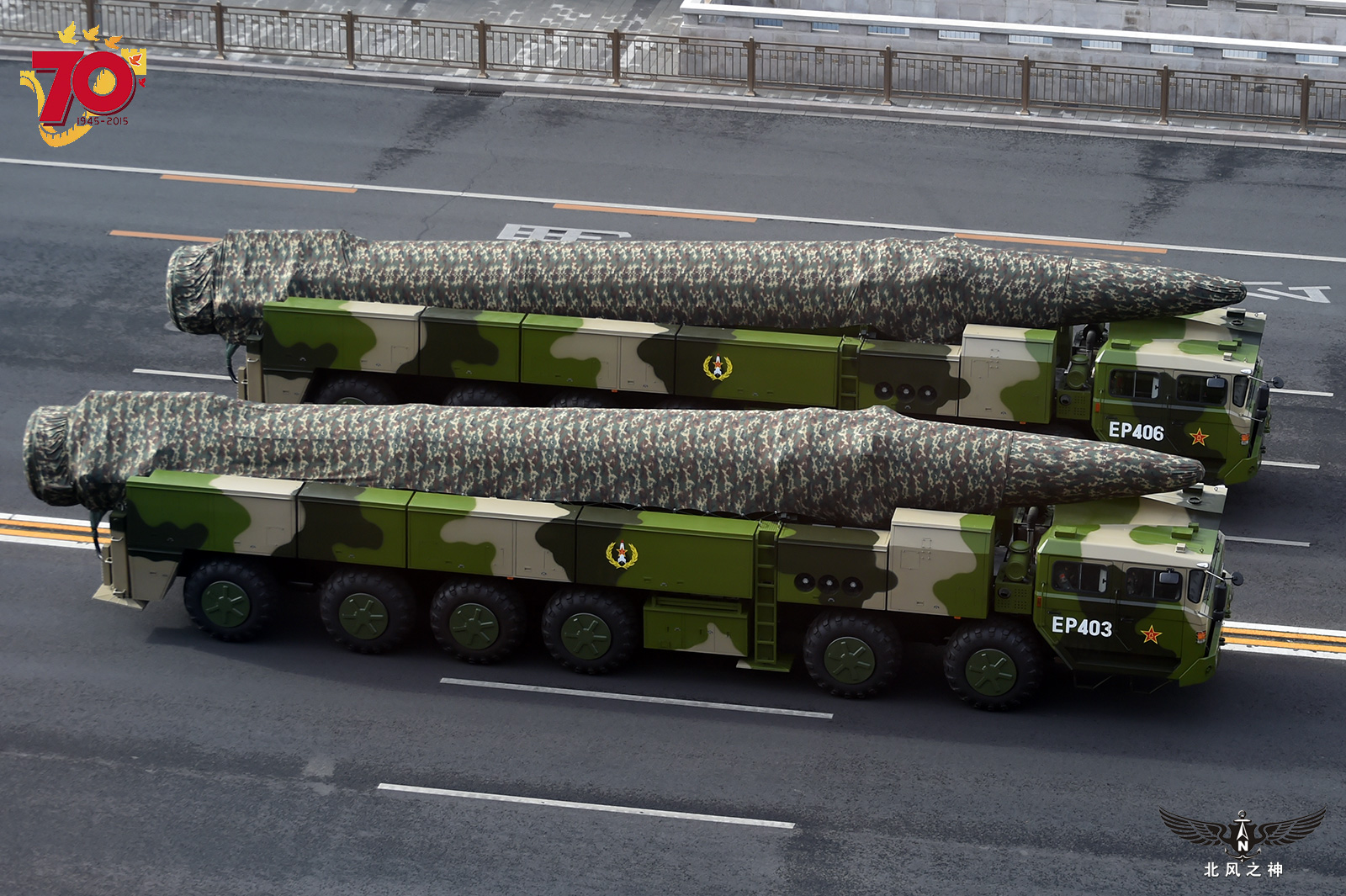
The HTF-5680 model TELs developed for the IRBM DF-26 ballistic missile.
During this exercise, the battalions of this DF-26 brigade were ordered to disperse to five shooting sites. Operators have been trained in camouflage against the passage of reconnaissance satellites, countermeasures against communication interference, as well as resistance to precision and biochemical strikes.
According to Colonel LU Kang Wen (吕康文), commander of the brigade in maneuver, this night exercise aims to check the ability of its troops to carry out the burst fire, the rapid launch and also the redeployment on several different sites.
Thanks to a suspensive base placed at the bottom of the missile tube, like the RSD-10Pioneer missile system (NATO Code SS-20), the launch of DF-26 no longer requires well-prepared firing sites And in fixed coordinates. It can, in principle, be launched without restrictive condition of the ground, thus improving the mobility and survival of the TEL, and the speed of launch.
It should be noted that LU had been responsible for the equipment service of another DF-21D anti - ship ballistic missile brigade based in Qingyuan, southern China. This promotion to the command of a DF-26 brigade therefore remains consistent because this IRBM ballistic missile, with a range of 4 to 5,000 km, also has the function of striking large naval targets such as aircraft carriers .
This element also suggests that the DF-26 brigade in question is also based in southern China, probably in the mountainous province of Yunnan. It could therefore be a new unit equipped with this long-range ballistic missile.
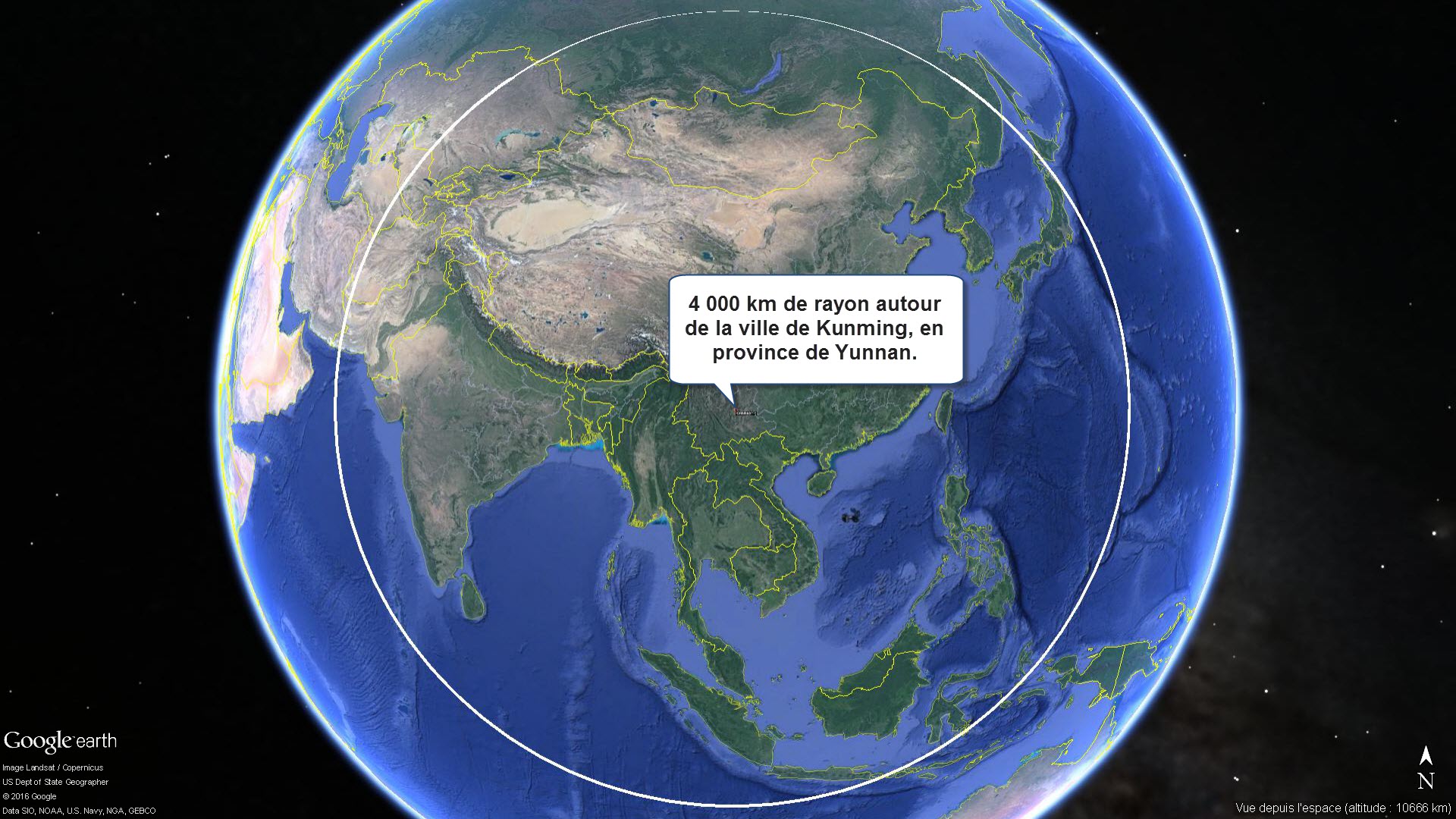
The (estimated) range of the DF-26 missile from Kunming, southern China.
A final point of interest - At the end of the CCTV-7 report, TELs of DF-21D can also be seen. Although the idea is tempting to say that the Chinese rocket forces are maneuvering together two types of anti-ship ballistic missiles, but in reality these sequences most likely have nothing to do with the fast fire of DF-26 'right here.
Henri K.
Share this article

A brigade of Chinese rocket forces recently conducted a nocturnal exercise during whichDF-26 long range ballistic missile simulations were conducted, based on a new TV report from the national channel CCTV-7.
Although the military journalists of the Chinese army did not reveal any information about the missile unit, location or even the missile model, it was still possible to identify the missile with a few images identified in the video .
Indeed, the TELs (Tractor-Erector-Launcher) vehicles that can be seen at the beginning of the report have six axles, two in the front and four in the rear. This configuration is typical of the TEL 12 × 12 of DF-26, model HTF-5680 designed by the Taian subsidiary of the Chinese group CASC.
One can also notice the conical "hollow", of particular shape which distinguishes it from that of the TELs of DF-21C and DF-21D, which can be seen in the middle of the driver's cabin in a passage of the video.

The TEL 12 × 12 of the DF-26

DF-26 TEL cab, noticing conical shape in the middle.

The HTF-5680 model TELs developed for the IRBM DF-26 ballistic missile.
During this exercise, the battalions of this DF-26 brigade were ordered to disperse to five shooting sites. Operators have been trained in camouflage against the passage of reconnaissance satellites, countermeasures against communication interference, as well as resistance to precision and biochemical strikes.
According to Colonel LU Kang Wen (吕康文), commander of the brigade in maneuver, this night exercise aims to check the ability of its troops to carry out the burst fire, the rapid launch and also the redeployment on several different sites.
Thanks to a suspensive base placed at the bottom of the missile tube, like the RSD-10Pioneer missile system (NATO Code SS-20), the launch of DF-26 no longer requires well-prepared firing sites And in fixed coordinates. It can, in principle, be launched without restrictive condition of the ground, thus improving the mobility and survival of the TEL, and the speed of launch.
It should be noted that LU had been responsible for the equipment service of another DF-21D anti - ship ballistic missile brigade based in Qingyuan, southern China. This promotion to the command of a DF-26 brigade therefore remains consistent because this IRBM ballistic missile, with a range of 4 to 5,000 km, also has the function of striking large naval targets such as aircraft carriers .
This element also suggests that the DF-26 brigade in question is also based in southern China, probably in the mountainous province of Yunnan. It could therefore be a new unit equipped with this long-range ballistic missile.

The (estimated) range of the DF-26 missile from Kunming, southern China.
A final point of interest - At the end of the CCTV-7 report, TELs of DF-21D can also be seen. Although the idea is tempting to say that the Chinese rocket forces are maneuvering together two types of anti-ship ballistic missiles, but in reality these sequences most likely have nothing to do with the fast fire of DF-26 'right here.
Henri K.
Share this article
Last edited:
Hendrik_2000
Lieutenant General
Hendrik_2000
Lieutenant General
Henri K post on the new sighting of DF26B He believes it is anti ship version that they tested with range of 3600 Km. The question now is how difference the B version compare to A version?. more range, more accuracy, more hardened ?
Forbin posted it in the missile thread but this is anti ship variant and not ground to ground version
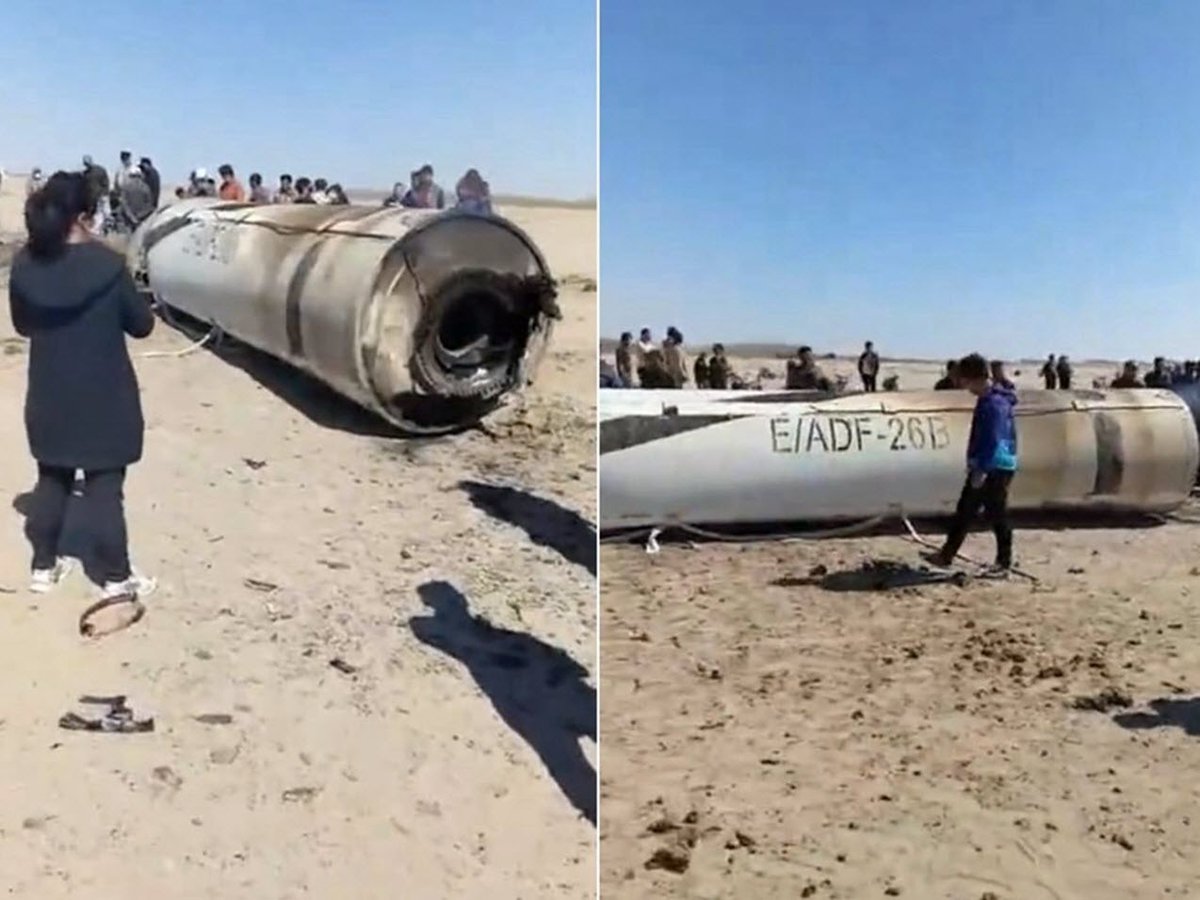
Chinese rocket forces - the country's strategic deterrent - may have completed a new operational test for the DF-26B ballistic missile , a variant of the IRBM / DF-26 long rangeASBM, by April if it is believed An amateur video taken in Inner Mongolia.
Filmed visibly with a mobile phone, it can be seen that the author revolved around a cylindrical object about 5 meters long and 1.5 meters in diameter, on which is a clear inscription of " E / ADF-26B ".
The letter E here means Er ( 二 in Chinese) which stands for 二炮 , former name of the strengths of Chinese rockets. And the letter A is the acronym of "Missile" according to the Chinese nomination standard.
It is therefore, if our first evaluation is accurate, a ballistic missile of model DF-26B of the forces of the Chinese rockets.
This hull, which is likely to be that of the first or second stage of the missile, plus another wreck smaller in size and embedded in the ground on the side, was found by the local inhabitants of the Siziwang banner, a subdivision Administrative authority of the Autonomous Region of Inner Mongolia, according to the author of the video. The faces of the people filmed seem to confirm this very valuable information.
Indeed, the Siziwang banner is not on the usual route of Chinese ballistic test shots, which is expected to be much further west, over a large area between Ningxia and Xinjiang provinces.
This implies that the DF-26B is launched from Northeast China, over the Korean Peninsula, and across the country to the west.
Consider now all the bases of the Chinese rocket forces, the only possible missile starting points, which correspond to these hypotheses, are located in Jingyu or Tonghua of base No. 51 in Jilin Province near the northern border Korean.
The location of the Siziwang banner.
The possible trajectory of the launch of DF-26B.
Assuming that the DF-26B missile has actually left Tonghua for example, it will be noticed that the straight line across Tonghua and the Siziwang banner joins Minfeng, a Chinese ballistic test impact site south of the Taklamakan Desert.
And, the distance between Tonghua and Minfeng is just over 3,700 km, equivalent to the estimated range of DF-26.
From Tonghua to Minfeng, passing by the banner of Siziwang.
All of these elements therefore suggest that a combat unit of the Chinese rocket forces carried out this operational shooting in "Full Range" mode.
Knowing that the DF-26 is officially presented as an IRBM ballistic missile capable of carrying nuclear or conventional charges, in order to strike fixed ground targets or "large ships" in motion, we have several possibilities to know To what corresponds this variant DF-26B:
Finally, when was this DF-26B shot?
The amateur video was posted for the first time on Sunday, April 23rd. However, there has been no officially published notification, such as NOTAMs, to indicate the firing. And we are not sure whether the date on which the video was mailed corresponds to the launch date.
By looking in our tracking database on Chinese ballistic missiles that took place before April 23, some could match the trajectory sought. One can quote for example the shot of 13 April, or .
In yellow line, the aerial segments closed during the ballistic tests of 13 and 15 April.
It should be noted that this may not be the first operational shot of DF-26B. Indeed, if we compare the photos of the wreck of another DF-26 shot that took place in August 2016, there are indeed similarities. For those who are interested, you can consult our file " " and make your own ideas.
To be continued.
Henri K.
Share this article
Forbin posted it in the missile thread but this is anti ship variant and not ground to ground version

Chinese rocket forces - the country's strategic deterrent - may have completed a new operational test for the DF-26B ballistic missile , a variant of the IRBM / DF-26 long rangeASBM, by April if it is believed An amateur video taken in Inner Mongolia.
Filmed visibly with a mobile phone, it can be seen that the author revolved around a cylindrical object about 5 meters long and 1.5 meters in diameter, on which is a clear inscription of " E / ADF-26B ".
The letter E here means Er ( 二 in Chinese) which stands for 二炮 , former name of the strengths of Chinese rockets. And the letter A is the acronym of "Missile" according to the Chinese nomination standard.
It is therefore, if our first evaluation is accurate, a ballistic missile of model DF-26B of the forces of the Chinese rockets.
This hull, which is likely to be that of the first or second stage of the missile, plus another wreck smaller in size and embedded in the ground on the side, was found by the local inhabitants of the Siziwang banner, a subdivision Administrative authority of the Autonomous Region of Inner Mongolia, according to the author of the video. The faces of the people filmed seem to confirm this very valuable information.
Indeed, the Siziwang banner is not on the usual route of Chinese ballistic test shots, which is expected to be much further west, over a large area between Ningxia and Xinjiang provinces.
This implies that the DF-26B is launched from Northeast China, over the Korean Peninsula, and across the country to the west.
Consider now all the bases of the Chinese rocket forces, the only possible missile starting points, which correspond to these hypotheses, are located in Jingyu or Tonghua of base No. 51 in Jilin Province near the northern border Korean.
The location of the Siziwang banner.
The possible trajectory of the launch of DF-26B.
Assuming that the DF-26B missile has actually left Tonghua for example, it will be noticed that the straight line across Tonghua and the Siziwang banner joins Minfeng, a Chinese ballistic test impact site south of the Taklamakan Desert.
And, the distance between Tonghua and Minfeng is just over 3,700 km, equivalent to the estimated range of DF-26.
From Tonghua to Minfeng, passing by the banner of Siziwang.
All of these elements therefore suggest that a combat unit of the Chinese rocket forces carried out this operational shooting in "Full Range" mode.
Knowing that the DF-26 is officially presented as an IRBM ballistic missile capable of carrying nuclear or conventional charges, in order to strike fixed ground targets or "large ships" in motion, we have several possibilities to know To what corresponds this variant DF-26B:
- A variant Ground-Ground nuclear
- A conventional Ground-Ground variant
- A conventional Ground-Sea variant
- An extended range variant
Finally, when was this DF-26B shot?
The amateur video was posted for the first time on Sunday, April 23rd. However, there has been no officially published notification, such as NOTAMs, to indicate the firing. And we are not sure whether the date on which the video was mailed corresponds to the launch date.
By looking in our tracking database on Chinese ballistic missiles that took place before April 23, some could match the trajectory sought. One can quote for example the shot of 13 April, or .
In yellow line, the aerial segments closed during the ballistic tests of 13 and 15 April.
It should be noted that this may not be the first operational shot of DF-26B. Indeed, if we compare the photos of the wreck of another DF-26 shot that took place in August 2016, there are indeed similarities. For those who are interested, you can consult our file " " and make your own ideas.
To be continued.
Henri K.
Share this article
Last edited:
Lethe
Captain
Why does the TEL cab in the previous post have a conical protrusion from the roof when the missile itself does not seem to lie in the hollow that is formed above?
The first thought that occurred to me is that it could be a safety measure to prevent the cab from being crushed if the missile breaks free while the vehicle is braking, but one would think it would be possible to secure the missile in a way that did not compromise cabin volume and therefore crew comfort and visibility.
The first thought that occurred to me is that it could be a safety measure to prevent the cab from being crushed if the missile breaks free while the vehicle is braking, but one would think it would be possible to secure the missile in a way that did not compromise cabin volume and therefore crew comfort and visibility.
Why does the TEL cab in the previous post have a conical protrusion from the roof when the missile itself does not seem to lie in the hollow that is formed above?
Yes it does. The parade missiles were elevated very slightly from their rest positions. Look closely at the cabs in the parade photo and you can see the dent.
SamuraiBlue
Captain
Henri K post on the new sighting of DF26B He believes it is anti ship version that they tested with range of 3600 Km. The question now is how difference the B version compare to A version?. more range, more accuracy, more hardened ?
Forbin posted it in the missile thread but this is anti ship variant and not ground to ground version

Chinese rocket forces - the country's strategic deterrent - may have completed a new operational test for the DF-26B ballistic missile , a variant of the IRBM / DF-26 long rangeASBM, by April if it is believed An amateur video taken in Inner Mongolia.
Filmed visibly with a mobile phone, it can be seen that the author revolved around a cylindrical object about 5 meters long and 1.5 meters in diameter, on which is a clear inscription of " E / ADF-26B ".
The letter E here means Er ( 二 in Chinese) which stands for 二炮 , former name of the strengths of Chinese rockets. And the letter A is the acronym of "Missile" according to the Chinese nomination standard.
It is therefore, if our first evaluation is accurate, a ballistic missile of model DF-26B of the forces of the Chinese rockets.
This hull, which is likely to be that of the first or second stage of the missile, plus another wreck smaller in size and embedded in the ground on the side, was found by the local inhabitants of the Siziwang banner, a subdivision Administrative authority of the Autonomous Region of Inner Mongolia, according to the author of the video. The faces of the people filmed seem to confirm this very valuable information.
Indeed, the Siziwang banner is not on the usual route of Chinese ballistic test shots, which is expected to be much further west, over a large area between Ningxia and Xinjiang provinces.
This implies that the DF-26B is launched from Northeast China, over the Korean Peninsula, and across the country to the west.
Consider now all the bases of the Chinese rocket forces, the only possible missile starting points, which correspond to these hypotheses, are located in Jingyu or Tonghua of base No. 51 in Jilin Province near the northern border Korean.
The location of the Siziwang banner.
The possible trajectory of the launch of DF-26B.
Assuming that the DF-26B missile has actually left Tonghua for example, it will be noticed that the straight line across Tonghua and the Siziwang banner joins Minfeng, a Chinese ballistic test impact site south of the Taklamakan Desert.
And, the distance between Tonghua and Minfeng is just over 3,700 km, equivalent to the estimated range of DF-26.
From Tonghua to Minfeng, passing by the banner of Siziwang.
All of these elements therefore suggest that a combat unit of the Chinese rocket forces carried out this operational shooting in "Full Range" mode.
Knowing that the DF-26 is officially presented as an IRBM ballistic missile capable of carrying nuclear or conventional charges, in order to strike fixed ground targets or "large ships" in motion, we have several possibilities to know To what corresponds this variant DF-26B:
But considering the scope of the firing, the location of its launch and the geopolitical context of the moment, we are focusing more on the third possibility, namely a long-range anti-ship variant. This remains to be confirmed, of course.
- A variant Ground-Ground nuclear
- A conventional Ground-Ground variant
- A conventional Ground-Sea variant
- An extended range variant
Finally, when was this DF-26B shot?
The amateur video was posted for the first time on Sunday, April 23rd. However, there has been no officially published notification, such as NOTAMs, to indicate the firing. And we are not sure whether the date on which the video was mailed corresponds to the launch date.
By looking in our tracking database on Chinese ballistic missiles that took place before April 23, some could match the trajectory sought. One can quote for example the shot of 13 April, or .
In yellow line, the aerial segments closed during the ballistic tests of 13 and 15 April.
It should be noted that this may not be the first operational shot of DF-26B. Indeed, if we compare the photos of the wreck of another DF-26 shot that took place in August 2016, there are indeed similarities. For those who are interested, you can consult our file " " and make your own ideas.
To be continued.
Henri K.
Share this article
My personal observation, it looks as if it has been staged.
First if it was either the first or second stage where is the engine bell?
Why are there so many people at the crash site, it's in the middle of no where and still such a crowd?
If it was the either the first or second stage it would have been wrecked into pieces not being able to withstand the impact.
If it was the second stage suggested from the distance from launch it would have been charred beyond recognition due to reentry not being able to read anything on the body and yet you can read the numbers.
manqiangrexue
Brigadier
All Chinese missile tests are staged, SadBlue. China has no missiles. Go back to sleep LOLMy personal observation, it looks as if it has been staged.
First if it was either the first or second stage where is the engine bell?
Why are there so many people at the crash site, it's in the middle of no where and still such a crowd?
If it was the either the first or second stage it would have been wrecked into pieces not being able to withstand the impact.
If it was the second stage suggested from the distance from launch it would have been charred beyond recognition due to reentry not being able to read anything on the body and yet you can read the numbers.

